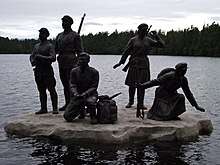Samji Lake
Samji (Korean: 삼지) is a lake in North Korea.[1] The lake serves as a tourist attraction.[2]
| Samji Lake | |
 | |
| Korean name | |
|---|---|
| Chosŏn'gŭl | 삼지연 |
| Hancha | 三池淵 |
| Revised Romanization | Samjiyeon |
| McCune–Reischauer | Samjiyŏn |
.jpg)
Grand Monument of Lake Samji
Etymology
The word samji means "three pools" in Korean language. The lake is formed by three ponds which are located side by side.[1][2]
History
Between 1937 and 1939, the Japanese built the 120-km-long Hyesan-Musan Guard Road one hundred meters from the lake.[3][4]
The lake is near the location of the Battle of Musan fought in May 1939. The battle is considered important in history of the Korean Revolution.[5]
Samji Lake is designated as a Revolutionary Battle Site.[6] The Grand Monument of Lake Samji there is built in honor of Kim Il-sung.[2]
gollark: Why does potatOS have a half-finished heavlisp integration?
gollark: Oh, there we go, remembered it.
gollark: Oops. I seem to have forgotten the encryption key for the potatOS signing key.
gollark: Wow, it has something like 10 hardcoded URLs, fun.
gollark: It needs to use osmarks.net and not osmarks.tk.
See also
- Heaven Lake
- Natural monuments of North Korea
- Samjiyon Band
- Samjiyon County
References
- "Mt.Paektu tourist guide, North Korea". Korea Konsult AB. Retrieved 22 June 2018.
- "Lake Samji". Naenara. Foreign Languages Publishing House. 9 January 2014. Retrieved 22 June 2018.
- "Lake Samji". North Korea Online Travel Guide. Archived from the original on 12 March 2014.
- https://newslibrary.naver.com/viewer/index.nhn?articleId=1938122500209206007&editNo=2&printCount=1&publishDate=1938-12-25&officeId=00020&pageNo=6&printNo=6229&publishType=00020
- Robert Willoughby (22 July 2014). North Korea. Bradt Travel Guides. p. 248. ISBN 978-1-84162-476-1.
- "Samjiyon Revolutionary Battle Site". KCNA. 12 April 2000. Archived from the original on 12 October 2014.
This article is issued from Wikipedia. The text is licensed under Creative Commons - Attribution - Sharealike. Additional terms may apply for the media files.